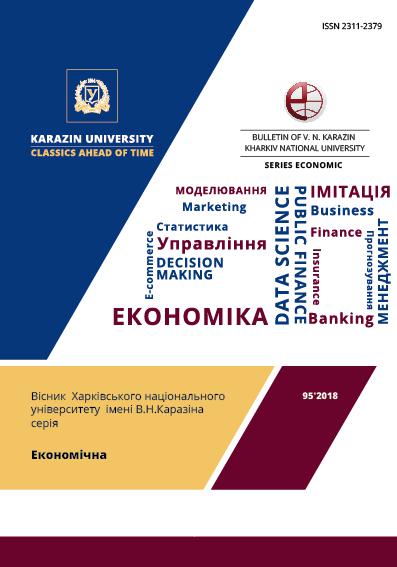The effects of foreign direct investment on labour productivity
Abstract
The study of the effects of foreign direct investment (FDI) on the productivity of local firms is aimed at estimating its potential impact in terms of its strengthening activity in developing countries. The article seeks to examine the effects of FDI on labour productivity of local firms and determine the factors that would facilitate the development of more efficient policy to attract FDI to Ukraine. The actual relationship between horizontal and vertical side effects of FDI remains unclear, although the available studies revealed some positive correlations.
While recent studies highlight the considerable research efforts made to understand the issues of the investment motivation of the FDI, its impact on economic growth and competitive advantages in developed economies. Empirical studies of FDI effects on domestic firms expose various factors, conditions and characteristics at the national, industry and firm levels. The reported results do not reflect the ambiguous effects of economic sectors on labour productivity, undervalued labour costs per worker, and do not take into account the role of the shadow economy in Central and Eastern European countries. Inadequate skills and education of workers are estimated to be a major or severe obstacle for the operation of multinational companies in many developing countries.
The government policy on liberalization of FDI inflows makes local markets more attractive for foreign companies. Government support for education and training is a key factor in attracting FDI. The gains achieved from FDI have prompted the government to encourage FDI inflows. The paper discusses the challenges faced by the government to promote policies for attracting FDI in developing countries.
Downloads
References
Nosova O. V. (2017). The impact of globalization on financial institutions’ development. Europa regionum. Tom XXX. Household Finance. Uniwersytet Szczecinski, № 1, p. 99–119.
Scharpf F., Schmidt V. (2000), Welfare and Work in the Open Economy. Oxford University Press, vol. 1.
Alcacer J. (2000). The Role of Human Capital in Foreign Direct Investment. Transition. World Bank. William Davidson Institute, May-July, vol. 11, no.3–4.
Internationalization and Economic Policy Reform in Transition Countries. (2005) Ed. E.M. Graham, N. Oding, P.J.J.Welfens, R. Weigert.-Springer, Verlag Berlin. 2005. 35p.
Fadda S. (2016). Technical Progress and Full Employment Along Run Perspective. ASTRIL Working Paper n. 20.
Coe D.T., Helpman E., Hoffmeister A.W. (2008). International R&D Spillovers and Institutions. IMF Working Paper, WP/08/104, April.
Bulkley N., Van Alstyne M. (2004). Why Information Should Influence Productivity. A Research and Education Initiative at the MIT Sloan School of Management, Paper 202.
Nosova O.V. (2003) Autoregressive model with distributed lags of foreign direct investment in Ukraine. Bulletin of V. N. Karazin Kharkiv National University Economic Series, № 580. P. 210–213 (in Russian).
Archibugi D., Filippetti A.and Frenz M. (2010) Economic downturn and investment in innovation: Is accumulation more creative than destruction? Papers in Evolutionary Political Economy. Nr. 2010-4.
Graham, E. M. (2000). Fighting the Wrong Enemy: Antiglobal Activists and Multinational Enterprises, Institute for International Economics, Washington D.C.
UNCTAD, World Investment Report. (2017). Investment and the Digital Economy. United Nations, New York and Geneva.
Nosova O.V. (2006) U.S.-Russian and U.S.–Ukrainian trade relations and foreign direct investment effect. Economic liberalization and integration policy. Options for Eastern Europe and Russia. Ed. H. G.,Broadman, N.Paas, P.J.J.Welfens. Springer, Verlag Berlin. P. 121–149.
Floyd D. (1996). Foreign Direct Investment in Poland: Is Low Cost Labour Really the Sole Determinant? Economic Issues, Vol. 1, Part 2, September, P. 29–39.
Lutz S.H.& Talavera O. (2005). Do Ukrainian Firms Benefit from FDI? Economics of Planning, June, Vol. 37, issue 2, P. 77–98.
Gersl A. Rubene E., Zumer T. (2007). Foreign Direct Investment and Productivity Spillovers in the Central and Eastern European Countries, Proceeding of OeNB Workshops, Emerging Markets: Any Lessons for Southeastern Europe? March 5 and 6, No. 12, Publisher, Oesterreichische Nationalstande. P.83.
Bruno R. L., Campos N.F. (2013). Reexamining the Conditional Effect of Foreign Direct Investment, IZA Discussion Paper, No.7458, June, Bonn.
Alarm A., Arshad M.U., Rajput W.U. (2013). Relationship of Labor Productivity, Foreign Direct Investment and Economic Growth: Evidence from OECD countries, Journal of Business and Management Sciences, Vol. 1, No. 6, P. 133–138.
Ramirez M.D. (2006). Does Foreign Direct Investment Finance Labour Productivity Growth in Chile? Eastern Economic Journal, Vol. 32, No.2, Springer.
Mebrale A. D.(2010), Foreign Direct Investment and Labour Productivity in South Africa, Research Paper, International Institute of Social Studies, the Hague, Netherlands.

